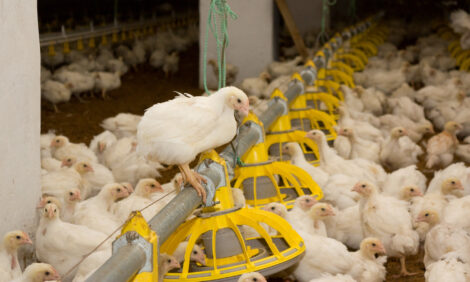



Mycoplasma gallisepticum Transmission: Comparison of Commercial F-strain Vaccine versus Layer Complex-derived Field Strains
In neither of two trials conducted in Mississippi did any laying hens or turkeys housed down-airstream from inoculated birds in a tunnel-ventilated house show evidence of clinical signs of mycocplasmosis, and none showed either serological or cultural evidence of mycoplasmosis.In a study of Mycoplasma gallisepticum (MG) transmission in layers and turkeys, J.L. Purswell of the USDA-Agricultural Research Service's South Central Poultry Research Laboratory and co-authors there and at Mississippi State University compared a commercial F-strain vaccine versus layer complex-derived field strains in a tunnel-ventilated house.
Their paper in Poultry Science describes two simultaneous trials conducted using a commercially available, live, F strain MG (FMG) vaccine (trial 1) or two inocula of layer complex-derived MG strains (LCD-MG; trial 2).
In each of the two trials, four commercial turkeys were housed in each of two adjoining pens immediately adjacent to air inlets. The turkeys (eight birds per trial) were inoculated in the right eye with either a single dose of FMG (trial 1) or with 0.02mL of one of two actively growing LCD-MG inocula (four turkeys per inoculum; trial 2).
In each of the two trials, one pen housing four inoculated turkeys was maintained without the addition of other poultry, whereas 16 MG-free broilers and four MG-free layers were added to the other pen of four inoculated turkeys.
Within each of the trials and at increasing intervals, either four layers (three pens) or four turkeys (three pens) were placed down-airstream from the inoculated pens. The distance of the first pen from the inoculated turkeys was separated by the width of one pen that was empty. Succeeding down-airstream pens were situated such that the empty distance (absence of any poultry) between pens that contained poultry doubled from one pen to the next such that the final pen that contained poultry had four empty pens between it and the next up-airstream pen that also contained poultry.
At 106 days post inoculation, all poultry were bled, swabbed for MG from the choanal cleft, and then euthanised and necropsied.
No commingled poultry in trial 1 (FMG), whether inoculated (turkeys) or commingled (layers and broilers), died during the course of the trial, and five of the eight FMG-vaccinated turkeys exhibited serological but not cultural evidence of mycoplasmosis.
In trial 2 (LCD-MG), two commingled broilers died and no inoculated turkeys exhibited either serological or cultural evidence of mycoplasmosis.
Purswell and co-authors reported that in neither trial did any poultry housed down-airstream from the inoculated birds show evidence of clinical signs of mycocplasmosis and none showed either serological or cultural evidence of mycoplasmosis.
Reference
Purswell J.L., J.D. Evans, S.A. Leigh, S.D. Collier, H.A. Olanrewaju, E.J. Kim, G.T. Pharr, E.D. Peebles and S.L. Branton. 2012. Mycoplasma gallisepticum transmission: Comparison of commercial F-strain vaccine versus layer complex-derived field strains in a tunnel ventilated house. Poult. Sci. 91(12): 3072-3079. doi: 10.3382/ps.2012-02619
Further ReadingYou can view the full report (fee payable) by clicking here.Find out more information on Mycoplasma gallisepticum by clicking here. |
January 2013









